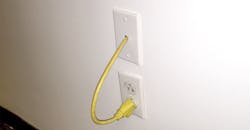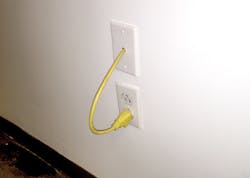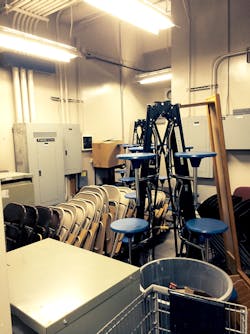How well do you know the Code? Think you can spot violations the original installer either ignored or couldn’t identify? Here’s your chance to moonlight as an electrical inspector and second-guess someone else’s work from the safety of your living room or office. Can you identify the specific Code violation(s) in this photo? Note: Submitted comments must include specific references from the 2017 NEC.
Hint: Wall power
August Winner
Our qualified winner this month — John Fitzpatrick, an electrical engineer with CDH Partners of Marietta, Ga. — knew there were some problems with this electrical room being used as a storage space. I would like to thank one of our readers, who prefers to remain anonymous, for sending us this photo of a classic violation of the working space rules for panelboards and switchboards.
Apparently, the message is not getting through to building owners and managers that the space in front of electrical panels must be kept clear. Readers continue to send me more and more photos of situations just like this one.
Section 110.26(B) could not be any clearer in its requirement that “working space required by this section shall not be used for storage.” We need to get this message out there! This is an all-too-common problem that puts the lives of electrical workers in jeopardy when they are forced to work in these overcrowded conditions. These jam-packed spaces can also cause a delay in an emergency when the power needs to be shut off quickly. A few seconds could mean the difference between life and death for a person who has received a shock.
About the Author

Russ LeBlanc
Owner
Russ started in the electrical trade as an apprentice in 1985. He worked his way up to become a Journeyman Electrician and then eventually became a Master Electrician and Licensed Construction Supervisor. In 1999 Russ become an Electrical Instructor for The Peterson School of Engineering in Massachusetts where he developed his passion for teaching, and quickly became Department Head of Electrical Instruction. Russ has taught thousands of apprentices, electricians, engineers, inspectors, and other electrical professionals during his career as an instructor. He continues to provide electrical professionals with Electrical Code seminars, Arc-Flash Awareness training seminars and educational material through his LeBlanc Consulting Services in North Reading, MA whose specialty is educating electricians. He has been an active member of the NFPA Electrical Section and has authored hundreds of National Electrical Code proposals and comments which have become Code rules to improve the safety for the electrical industry. Russ is also an IAEI certified Electrical Inspector.
Please visit www.russleblanc.net for more information.


